RESEARCH
E-health in low-and middle-income countries: findings from the Center for Health Market Innovations
E-santé dans les pays à revenu faible ou moyen: résultats du Center for Health Market Innovations (Centre pour les Innovations du Marché de la Santé)
Sanidad electrónica en países de ingresos bajos y medios: resultados del Centro para la Innovación en el Mercado Sanitario
Trevor LewisI,*; Christina SynowiecII; Gina LagomarsinoI; Julian SchweitzerI
IResults for Development Institute, 1100 15th Street NW (Suite 400), Washington, DC, 20005, United States of America (USA)
IILouisville, USA
ABSTRACT
OBJECTIVE: To describe how information communication technology (ICT) is being used by programmes that seek to improve private sector health financing and delivery in low-and middle-income countries, including the main uses of the technology and the types of technologies being used.
METHODS: In-country partners in 16 countries directly searched systematically for innovative health programmes and compiled profiles in the Center for Health Market Innovations' database. These data were supplemented through literature reviews and with self-reported data supplied by the programmes themselves.
FINDINGS: In many low-and middle-income countries, ICT is being increasingly employed for different purposes in various health-related areas. Of ICT-enabled health programmes, 42% use it to extend geographic access to health care, 38% to improve data management and 31% to facilitate communication between patients and physicians outside the physician's office. Other purposes include improving diagnosis and treatment (17%), mitigating fraud and abuse (8%) and streamlining financial transactions (4%). The most common devices used in technology-enabled programmes are phones and computers; 71% and 39% of programmes use them, respectively, and the most common applications are voice (34%), software (32%) and text messages (31%). Donors are the primary funders of 47% of ICT-based health programmes.
CONCLUSION: Various types of ICT are being employed by private organizations to address key health system challenges. For successful implementation, however, more sustainable sources of funding, greater support for the adoption of new technologies and better ways of evaluating impact are required.
RÉSUMÉ
OBJECTIF: Décrire comment les technologies de l'information et de la communication (TIC) sont utilisées par des programmes visant à améliorer le financement du secteur privé dans le domaine de la santé et la prestation de soins de santé livraison dans les pays à revenu faible et moyen, et notamment les principaux usages des technologies et les types de technologie utilisés.
MÉTHODES: Les partenaires locaux de 16 16 pays ont fait des recherches directes et systématiques de programmes de santé innovateurs et ont compilé ces profils dans la base de données du Center for Health Market Innovations. Ces données ont été complétées par relevées dans des revues scientifiques et des données auto déclarée saussi fournies par les programmes eux-mêmes.
RÉSULTATS: Dans de nombreux pays à revenu faible et moyen, les TIC sont de plus en plus utilisées à des fins différentes dans divers buts et dans divers domaines liés à la santé. Parmi les programmes faisant appel aux utilisant les TIC, 42% les utilisent le font pour étendre géographiquement l'accès aux soins de santé, 38% % pour améliorer la gestion des données, et 31% pour faciliter la communication entre les patients et les médecins en dehors du cabinet médical. D'autres objectifs buts ont été constatés, comme tels que l'amélioration des diagnostics et des traitements (17%), la réduction des fraudes et des abus (8%) et la rationalisation simplification des transactions financières (4%). Les dispositifs appareils les plus couramment utilisés par les programmes basés sur la technologie sont le téléphone et l'ordinateur pour 71% % et 39% % d'entre eux respectivement, et les applications les plus courantes en sont la voix (34%), le logiciel (32%) et les SMS (31%). Les donateurs sont les principaux bailleurs de fonds pour de 47% des programmes de santé basés sur les TIC.
CONCLUSION: Différents types de TIC sont utilisés par les utilisées par des organisations privées pour relever les principaux des défis des clés dans les systèmes de santé. Une implémentation réussie de ces technologies exige cependant des sources de financement plus stables, un support plus important soutien accru pour l'adoption des nouvelles technologies et de meilleurs moyens pour en évaluer l'impact.
RESUMEN
OBJETIVO: Describir cómo se utiliza la tecnología de la comunicación y de la información (TIC) en los programas que aspiran a mejorar la financiación y el suministro de asistencia en el sector sanitario privado de países con ingresos bajos y medios, incluyendo las principales aplicaciones de la tecnología y los tipos de tecnologías que se utilizan.
MÉTODOS: Colaboradores nacionales de 16 países realizaron una búsqueda directa y sistemática de programas sanitarios innovadores y recopilaron perfiles en la base de datos del Centro para la Innovación en el Mercado Sanitario. Estos datos se complementaron con revisiones bibliográficas y datos procedentes de informes propios suministrados por los programas.
RESULTADOS: En muchos países con ingresos bajos y medios está aumentado el uso de la TIC para diferentes fines en diversas áreas relacionadas con la salud. De los programas sanitarios con TIC, el 42% la utilizan para ampliar el acceso geográfico a la asistencia sanitaria, el 38% para mejorar la gestión de datos y el 31% para facilitar la comunicación entre pacientes y médicos fuera de la consulta. Otros fines incluyen: la mejora del diagnóstico y el tratamiento (17%), la disminución del fraude y del abuso (8%) y la racionalización de las transacciones financieras (4%). Los dispositivos más utilizados en los programas con asistencia tecnológica son los teléfonos y ordenadores, empleados por los programas en un 71% y un 39% respectivamente, y las aplicaciones más comunes son la voz (34%), el software (32%) y los mensajes de texto (31%). Los donantes son los principales financiadores del 47% de los programas sanitarios basados en TIC.
CONCLUSIÓN: Las organizaciones privadas están utilizando varios tipos de TIC para abordar desafíos clave del sistema sanitario. No obstante, para que puedan implementarse de forma satisfactoria, es necesario disponer de fuentes de financiación más sostenibles, de un mayor apoyo para la adopción de nuevas tecnologías y de mejores vías de evaluación del impacto.
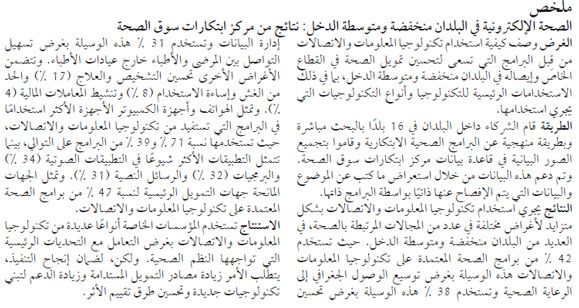

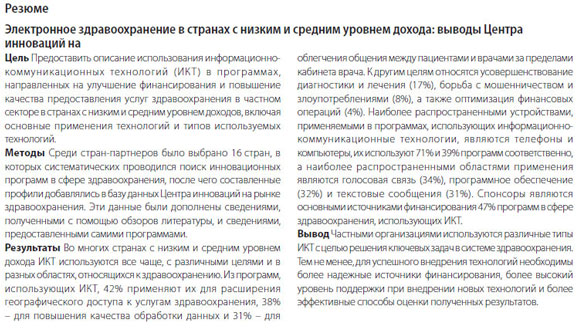
Introduction
Health systems in low-and middle-income countries continue to face considerable challenges in providing high-quality, affordable and universally accessible care. In response, policy-makers, donors and programme implementers are searching for innovative approaches to eliminate the geographic and financial barriers to health. This has resulted in mounting interest in the potential of e-health (the use of ICT for health) and m-health (the use of mobile technology for health, a subset of e-health) in low-and middle-income countries.
Developing countries are experiencing an unprecedented increase in the number of users of cell phone and internet technologies, as well as a decline in the price of devices and services.1 - 4 As a result, many health programme implementers and policy-makers are exploring the extent to which e-and m-health (henceforth referred to simply as e-health) can help address the challenges faced by resource-constrained health markets in terms of the availability, quality and financing of health care. This increasing interest is evidenced by the growing number of events, web sites and literature focused on e-health, including the Saving Lives at Birth Grand Challenge,5 the recent Health Affairs thematic issue on e-health in the developing world,6 the m-health summits that took place in Washington, DC, United States of America,7 and Cape Town,8 South Africa, and the survey recently conducted by the World Health Organization on the use of m-health by its Member States.1
Despite the increased interest -perhaps bordering on excess -in some individual programmes, in low-and middle-income countries the e-health field is still relatively nascent. Few programmes have gone to scale and implementation has typically been fragmented and uncoordinated. To date, the literature on e-health in low-and middle-income countries has largely consisted of articles describing single uses of technology in health care delivery,9, 10 as well as theoretical discussions and recommendations surrounding the implementation of e-health-based programmes and policies,11, 12 with few examinations of the actual global landscape of these programmes. One exception is a white paper commissioned by Advanced Development for Africa that lays out a series of case studies and provides best-practice recommendations from e-health experts.13 Another paper reviews the evidence on the impact of e-health in low-and middle-income countries.14 The aforementioned WHO survey of Member States' utilization of m-health 1 presents a systematic landscaping of health programmes; nevertheless, the survey relied on local government knowledge, which is often limited when it comes to the private sector, where much of the e-health activity is taking place.
By analysing health programmes in low-and middle-income countries that engage the private sector, our paper fills gaps in the e-health literature and provides new insight into several central questions. It examines specifically the geographic distribution of technology-enabled programmes, the key issues technology can address in the health sector, and the key challenges posed by the adoption and implementation of technology for health-related purposes.
Methods
Center for Health Market Innovations
This analysis of the e-health technology landscape (henceforth referred to as ICT or simply technology) relies on information obtained from the Center for Health Market Innovations' (CHMI) database.15 CHMI, launched in July 2010 and updated daily, systematically collects information on programmes and policies -implemented by a wide variety of public and private actors -that have the potential to improve health systems in low-and middle-income countries, where private providers tend to predominate and household out-of-pocket spending is a major source of health financing. These programmes use innovative delivery and financing mechanisms to improve access to health services, as well as their quality and affordability, for the poor. Examples include private clinical social franchises, vouchers for safe deliveries, high-volume/low-cost maternity hospitals with cross-subsidies for poor patients and government accreditation for private drug shops. Not all CHMI-documented programmes rely on innovative information technologies, but many do.1
Traditionally, clinics, hospitals, and public health programmes run by the government or by non-governmental organizations are outside the scope of CHMI and are excluded from this institution's database. Since CHMI focuses on programmes that work primarily with private providers, large-scale government e-health infrastructures, such as national electronic medical record systems, were not included in this analysis. Similarly, the database screens out programmes that serve mainly high-income populations and focuses on programmes targeting the poor or people in a range of income brackets.
CHMI data were obtained through systematic searches for innovative health programmes led by partners in 16 countries chosen for their thriving private sectors: Bangladesh, Bolivia, Brazil, Cambodia, Ecuador, India, Indonesia, Kenya, Pakistan, Peru, the Philippines, Rwanda, South Africa, Uganda, the United Republic of Tanzania and Viet Nam. Direct searches were supplemented by literature reviews and self-reported information obtained from the programmes themselves. As a result, the data were limited to the information captured by contributions to CHMI's database and do not include the full universe of all relevant programmes. Furthermore, CHMI's focus on private care delivery and its relationships with partner organizations in specific countries may have resulted in data collection biases. More information on the data collection methods can be found on CHMI's web site.16
At the time of this study, the database included 657 programmes, 176 of which were identified as "technology-enabled", that is, as deliberately using ICT to improve health. The programmes that passed this screening were those driven by technology as a core function, such as health insurance programmes whose client interactions take place entirely through smart-card technologies, or programmes that use technology as part of a broader health strategy, such as clinics offering comprehensive primary care but using cell phones for patient follow-up. Programmes not considered technology-enabled included those that use no form of ICT or do not report it as a key element that enhances their work. Based on this definition, a programme using an X-ray machine alone would not be classified as technology-enabled; however, if the X-ray machine were part of a remote diagnostic service using telemedicine, the programme would be classified as technology-enabled.
Two taxonomies were developed to categorize technology-enabled CHMI programmes: the type of technology used ( Box 1 ) and the purpose of the technology ( Box 2 ). All 176 programmes were coded in accordance with these taxonomies, which were then combined with comparable data collected on all programmes, such as geographic location, health focus (e.g. human immunodeficiency virus [HIV] infection and acquired immunodeficiency syndrome [AIDS], primary care, family planning) and source of funding, to identify emerging patterns in the technology landscape. Further insights were drawn from 20 qualitative interviews with a subset of programme implementers and from anecdotal self-reports on impact obtained from certain programmes.
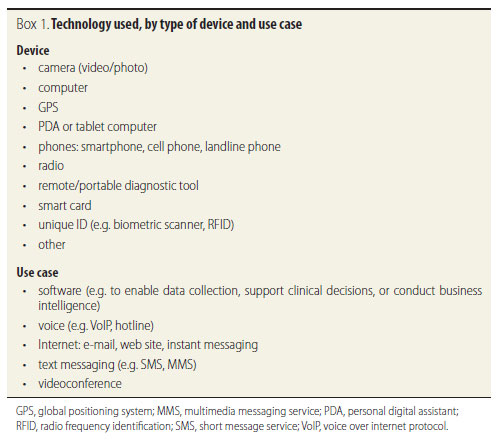
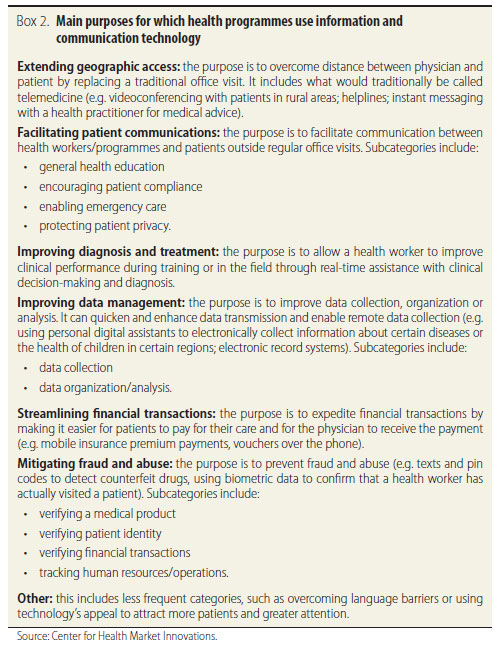
Our analysis captures the number of programmes using technology, not the scale of technology use, because this information is incomplete. Nevertheless, the limited information on scale does indicate a wide range in programme size. For example, several programmes report reaching hundreds of patients or users,17 whereas others claim to have reached thousands or more. A case in point is India's government-sponsored rashtriya swasthya bima yojana health insurance, which claims to have distributed over 27 million active smart cards to its subscribers.18
Results
Programme emergence
At the time of this study, 27% of CHMI-profiled programmes used technology as a core dimension of their work. The analysis by launch date of these 176 technology-enabled programmes ( Fig. 1 ) shows considerable growth in the field of e-health: only 8% of CHMI-profiled programmes launched in the early 1990s are currently using technology, compared with 43% of programmes launched in the last five years.
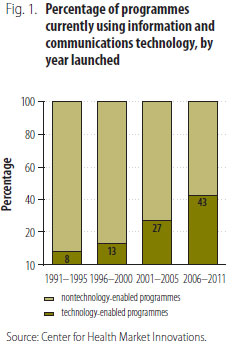
Technology-enabled programmes are emerging in all lower-income countries, as shown in Fig. 2. Southern Asia -India in particular -leads in terms of the absolute number of technology-enabled programmes, but the percentage of such programmes (out of all CHMI-profiled health programmes) is relatively uniform across regions.
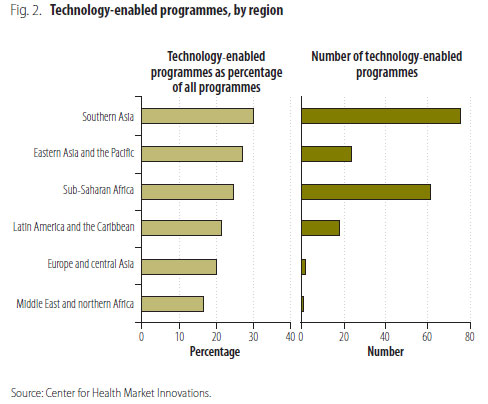
Technology solutions appear to be emerging across all areas of health, with HIV/AIDS, general primary care, and maternal and child health in the lead in terms of absolute numbers. However, ICT is more likely to be adopted in certain areas of health care, as shown in Fig. 3. For example, the majority (65%) of emergency programmes are technology-enabled, whereas only 31% of HIV/AIDS programmes use ICT.
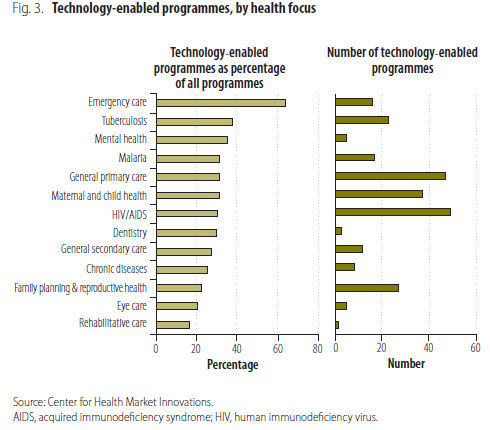
Technology-enabled programmes currently receive funding from a variety of sources ( Fig. 4 ), but 47% of the 176 programmes rely primarily on donors. The government is the main source of funding for 22% of the programmes, and out-of-pocket payments (patient fees), for 25%.

Types of technology solutions
The taxonomy for the type of technology used ( Box 1 ) was developed by coding all programmes on the basis of: (i) the device used (e.g. phone, camera) and (ii) the use case (e.g. videoconference, short messaging service [SMS]). Use case is the way in which the device is applied. Individual devices can link to multiple use cases (e.g. a phone can be used for voice and/or text messaging).
The data revealed that technology programmes rely mainly on phones and computers (71% and 39% of programmes, respectively, as shown in Table 1 ), and frequently on both. In particular, 63% of the programmes using phones rely exclusively on cell phones for their operations.
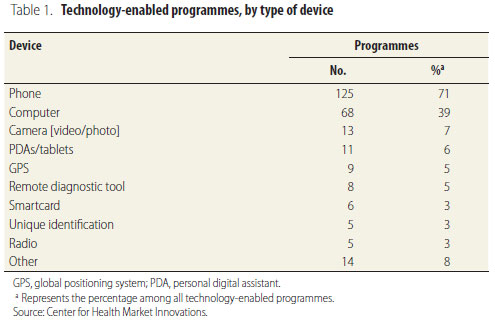
Closely tied to the device is the primary use case ( Fig. 5 ). Voice is the most frequent use case for technology devices. Just over 34% of programmes use voice; almost 32% use applications or other software, and approximately 31% use some form of text messaging (SMS).
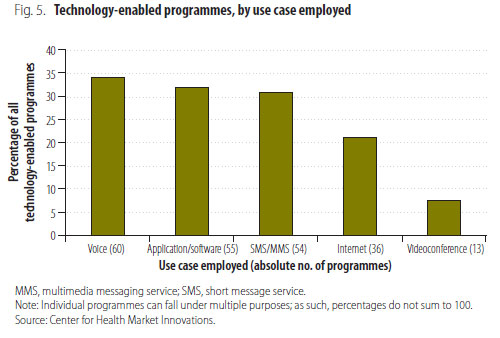
Purpose behind use of the technology
The taxonomy for the purpose behind the use of technology by health programmes ( Box 2 ) was developed through a review of the goals of each technology innovation. Six broad reasons surfaced, the most common one (42% of programmes) being to extend geographic access to health ( Fig. 6 ). Examples range from TeleDoctor in Pakistan, which provides access to physicians through a telephone hotline,19 to E Health Point in India, which facilitates patient-doctor interactions in rural areas through videoconferencing.20 The second most common purpose (38% of programmes) behind the use of technology is to improve data management. Within this category, 38% of programmes focus on data collection, 35% on data organization and analysis and 27% on both. For example, Nacer 21 uses telephone and internet technology to allow health workers in Peru to collect data on various populations and share it remotely with medical experts for data analysis. Facilitating patient communications outside regular health visits and improving diagnosis and treatment are the purposes behind technology use in 31% and 17% of the programmes, respectively. In addition, a few programmes use technology to mitigate fraud and abuse and to streamline financial transactions.
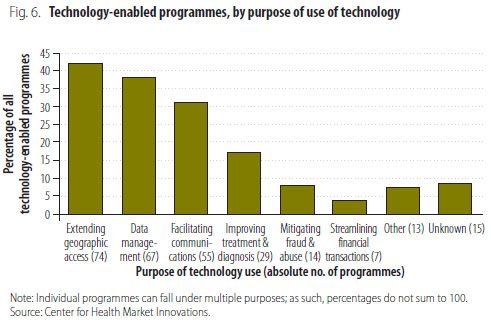
Discussion
The use of technology by a large percentage of programmes to extend geographic access to health care is particularly promising given the critical shortage of health workers and poor distribution of service providers in many low-and middle-income countries.22, 23 These programmes often take the form of telemedicine, which connects physicians and patients via technologies such as video chat, or health hotlines, which provide patients with around the clock access to qualified doctors. Interestingly, 70% of the programmes focused on improving diagnosis and treatment also use technology to extend access. These two purposes go hand-in-hand, especially when a programme aims to enable workers with less training to provide high-quality care by using clinical decision-support software to improve the quality and consistency of practice. For example, M-DOK was a pilot mobile health system that allowed rural community health workers in the Philippines to send patient information over text message to specialists in urban areas, who then advised on accurate diagnosis and appropriate treatment.24
Although mitigating fraud and abuse and streamlining financial transactions are the least common of the identified purposes for technology-use, this may be a major area of opportunity for e-health in the future. Low-and middle-income countries are seeking new solutions to improve oversight and accountability in health transactions. They can reduce the loss of scarce health care resources by monitoring drug purchases and verifying receipt of services before insurance payments are transferred. Mobile payment technologies, such as M-Pesa in East Africa, have become increasingly popular 25 and in all likelihood will continue to be used for streamlining financial transactions in health.
Devices and use case
Anecdotally, many policy-makers and funders seem to be particularly excited about the potential of newer, emergent technologies, such as tablets. Nevertheless, the expansion of mobile infrastructure and the concurrent increase in the use of telecommunication devices among the poor has allowed programmes to utilize existing devices and invest less in new technologies. This study shows that common technologies such as basic cell phones and computers are frequently used.
Interestingly, text messages fall third in the distribution of technology use cases, with voice and software/applications ranking higher, despite the global excitement over SMS.26, 27 Programme implementers have cited greater accessibility for illiterate populations as one of the advantages of voice messages over text messages.
Certain purposes are logically more closely associated with specific devices. This study found that 94% of programmes that facilitate patient communications outside traditional health visits use phones, while only 28% use computers. This is not surprising, since patients in low-income settings are more likely to own phones.
Health focus
Primary care staff require strong diagnostic skills, while secondary care providers need specialized knowledge about particular diseases and conditions. According to this study, programmes focused on primary and secondary care use technology primarily to extend geographic access to care (57% of general primary care and 75% of general secondary care programmes) and to improve treatment and diagnosis (26% and 67%, respectively). In this way, these programmes are able either to connect underserved patients with specialized and trained physicians or to improve the skills of lesser-trained health workers who are more accessible to the patients.
On the other hand, 43% of HIV/AIDS, 35% of tuberculosis and 33% of family planning and reproductive health programmes that are technology-enabled use technology to facilitate patient communications, which is thus one of their most important aims. This is probably because they require frequent low-level provider-patient interactions to ensure compliance with treatment protocols and impart general education.
Impact
Broadly assessing the impact of ICT programmes on indicators such as service access, quality, cost and efficiency was beyond the scope of this study for lack of the necessary data. However, 16 of the 176 technology-enabled programmes responded to a request for self-reported clear and quantifiable impacts, from improvements in the quality of care to decreased costs. Six programmes described an increase in user satisfaction, the most common impact reported. For example, 92% of the patients using GlicOnLine, which helps diabetics in Brazil calculate insulin dosages and plan their diet, reported that the system had improved their lifestyle.28 User satisfaction is a key impact, since acceptance by end users, whether patients or health workers, is a big concern for many e-health implementers. Five programmes reported improvements in the quality of care, often relating to increased patient adherence to the physician's recommendations or to drug regimens. Operation ASHA reports that its system, which uses fingerprint scanners to verify adherence to tuberculosis medication in slums in India, has decreased the fraction of patients who fail to complete treatment from 60% to less than 3%.29 Four programmes report an impact on efficiency, often in the form of time saved. The e-health community may see an increase in reports of efficiency impacts because it is natural for technology to have such an effect, particularly on account of ICT's ability to transfer data almost instantaneously. For example, the RapidSMS system in Malawi, which collects data on paediatric patients using mobile phones, has reduced transfer times for some data from 1 to 3 months to only 2 minutes.30 Similarly, decreased costs resulting from technology are reported by few programmes at present,31 but such reports could rise,31 especially as savings from increased efficiencies overcome initial capital costs. This small number of self-reported, quantifiable positive results suggests that e-health can have an impact, although more rigorous evaluation is needed.10
Barriers to implementation
As programmes look for opportunities to scale up e-health services, they may be hampered by persistent reliance on donor funding ( Fig. 4 ), which highlights the need for an eventual transition to alternative and diversified revenue sources (e.g. government contracts, insurance or direct payments from consumers) to bring effective programmes to scale. In addition, it appears to be more difficult to adapt an existing organization to a given technology than to build an organization with technology from scratch. Fig. 3 suggests that programmes launched before the advent of ICT are not rapidly adopting the new technologies. When this study was conducted, 73% of programmes in CHMI's database were not technology-enabled, and interviews with a selection of implementers suggest that organizations face important barriers to implementation. Implementers have pointed out problems with end-user acceptance of the technology attributable to factors such as the user's lack of familiarity with the technology, a lack of cultural appropriateness or a lack of incentive to adopt new tools. Another key concern is the lack of the necessary infrastructure to provide reliable electricity and internet access. One implementer cited this as a key reason for moving from computers to mobile phones, for which the necessary infrastructure is more readily available. Costs, both initial and ongoing, also surfaced as a key impediment to technology implementation. Such considerations may determine if, when, and how a technology is incorporated into a programme.
Conclusion
ICT is being deployed around the world in many areas of health. Six major reasons for the use of ICT in health have emerged in this paper. Some, such as extending access to care or improving data management, are rather common, but there are budding uses as well, specifically in fields such as mitigating fraud and abuse and streamlining financial transactions. These fields deserve special attention to ensure their proper development. As e-health continues to evolve, many of the current challenges faced by health systems in low-and middle-income countries, such as the shortage of health workers in rural areas, the variable quality of care, lack of patient compliance, and fraud, will potentially be mitigated through the wide deployment of ICT. It will be crucial to continue to track which of these purposes are being successfully fulfilled by technology and what devices and use cases are most effective in attaining them. This will require more systematic evaluations and better codification of lessons learnt from existing programmes, which in turn will allow programmes that are currently struggling to employ technology to make educated decisions about when and how to implement ICT. 
References
1. WHO Global Observatory for eHealth. mHealth: new horizons for health through mobile technologies. Geneva: World Health Organization; 2011 (Global Observatory for eHealth series).
2. Vital Wave Consulting. mHealth for development: the opportunity of mobile technology for healthcare in the developing world. Washington & Berkshire: UN Foundation-Vodafone Foundation Partnership; 2009.
3. International Telecommunication Union [Internet]. Worldwide mobile cellular subscribers to reach 4 billion mark late 2008: ITU estimates over 60 per cent penetration driven mainly by BRIC economies (press release). 2008 Sept 25. Available from: http://www.itu.int/newsroom/press_releases/2008/29.html [accessed 22 February 2012] .
4. Lambert O, Littlefield E. Dial growth: how handheld devices are enabling nascent economies to skip a generation of development. Finance Dev 2009;46:48-50.
5. Saving Lives at Birth: a grand challenge for development [Internet]. Washington: Grand Challenge for Development; 2011. Available from: http://www.savinglivesatbirth.net/ [accessed 22 February 2012] .
6. Dentzer S. E-health promise for the developing world. Health Aff 2010;29:229. doi: 10.1377/hlthaff.2010.0006
7. mHealth Summit [Internet]. Rockville: Foundation for the National Institutes of Health; c2008-2009. Available from: http://www.mhealthsummit.org/2010/ [accessed 22 February 2012] .
8. Mobile Health Summit [Internet]. GSM Association & mHealth Alliance; c2010. Available from: http://www.mobilehealthsummit.com/ [accessed 22 February 2012] .
9. Schenker JL. MPedigree's Rx for counterfeit drugs. Bloomberg Businessweek [Internet]. New York: Bloomberg L.P. 2008 Dec 3. Available from: http://www.businessweek.com/globalbiz/content/dec2008/gb2008123_027994.htm [accessed 22 February 2012] .
10. Otto K. MAMA Knows Best. The Huffington Post [Internet]. 2012 Jan 17. Available from: http://www.huffingtonpost.com/kate-otto/mama-knows-best_b_858645.html [accessed 22 February 2012]
11. Gerber T, Olazabal V, Brown K, Pablos-Mendez A. An agenda for action on global E-health. Health Aff (Milwood) 2010;29:233-6. doi: 10.1377/hlthaff.2009.0934 PMID: 20348066
12. Crean KW. Accelerating innovation in information and communication technology for health. Health Aff 2010;29:278-83. doi: 10.1377/hlthaff.2009.0795 PMID: 20348074
13. Lemaire J. Scaling up mobile health. Geneva: Advanced Development for Africa; 2011.
14. Blaya JA, Fraser HSF, Holt B. E-health technologies show promise in developing countries. Health Aff (Milwood) 2010;29:244-51. doi: 10.1377/hlthaff.2009.0894 PMID: 20348068
15. Center for Health Market Innovations [Internet]. Washington: CHMI; 2010. Available from: http://healthmarketinnovations.org/programs [accessed 22 February 2012]
16. Center for Health Market Innovations [Internet]. CHMI methodology. Washington: CHMI; 2011. Available from: http://healthmarketinnovations.org/about/chmi-approach/chmi-methodology [accessed 27 February 2012]
17. Center for Health Market Innovations [Internet]. Pesinet. Washington: CHMI; 2010. Available from: http://healthmarketinnovations.org/program/pesinet [accessed 22 February 2012] .
18. Center for Health Market Innovations [Internet]. Washington: CHMI; 2010. Rashtriya swasthya bima yojana (RSBY). Available from: http://healthmarketinnovations.org/program/rashtriya-swasthya-bima-yojana-rsby [accessed 22 February 2012] .
19. Center for Health Market Innovations [Internet]. TeleDoctor. Washington: CHMI; 2010. Available from: http://healthmarketinnovations.org/program/teledoctor-0 [accessed 22 February 2012] .
20. Center for Health Market Innovations [Internet]. E Health point. Washington: CHMI; 2011. Available from: http://healthmarketinnovations.org/program/e-health-point-0 [accessed 22 February 2012] .
21. Center for Health Market Innovations [Internet]. Nacer. Washington: CHMI; 2010. Available from: http://healthmarketinnovations.org/program/nacer [accessed 22 February 2012] .
22. The world health report 2006: working together for health. Geneva: World Health Organization; 2006.
23. World Health Organization & Global Health Workforce Alliance. The Kampala Declaration and Agenda for Global Action. Geneva: WHO; 2008.
24. Center for Health Market Innovations [Internet]. M-DOK: mobile telehealth and information resource system for community health workers in the Philippines. Washington: CHMI; 2010. Available from: http://healthmarketinnovations.org/program/m-dok-mobile-telehealth-and-information-resource-system-community-health-workers-philippines [accessed 22 February 2012] .
25. Out of thin air: the behind-the-scenes logistics of Kenya's mobile-money miracle. The Economist. 2010 June 10. Available from: http://www.economist.com/node/16319635 [accessed 22 February 2012] .
26. Bansal S. Can text messages be used to improve health outcomes? Forbes. 7 Oct 2011. Available from: http://www.forbes.com/sites/sarikabansal/2011/10/07/mhealth-text-message-txt2stop/ [accessed 22 February 2012] .
27. Sweeney C. How text messages could change global healthcare [Internet]. Popular Mechanics [Internet]. 2011 Oct 24. Available from: http://www.popularmechanics.com/science/health/med-tech/how-text-messages-could-change-global-healthcare
28. Center for Health Market Innovations [Internet]. GlicOnLine. Washington: CHMI; 2010. Available from: http://healthmarketinnovations.org/program/gliconline [accessed 22 February 2012] .
29. Center for Health Market Innovations [Internet]. Operation ASHA. Washington: CHMI; 2010. Available from: http://healthmarketinnovations.org/program/operation-asha [accessed 22 February 2012] .
30. Center for Health Market Innovations [Internet]. RapidSMS, Malawi. Washington: CHMI; 2010. Available from: http://healthmarketinnovations.org/program/rapidsms-malawi [accessed 22 February 2012] .
31. Schweitzer J, Synowiec C. The economics of eHealth. Washington: United Nations Foundation; 2010.
Submitted: 20 November 2011
Revised version received: 3 February 2012
Accepted: 21 February 2012
Funding: This study was funded by the Rockefeller Foundation and the Bill & Melinda Gates Foundation.
Competing interests: None declared.
* Correspondence to: Trevor Lewis (e-mail: tlewis@resultsfordevelopment.org).
